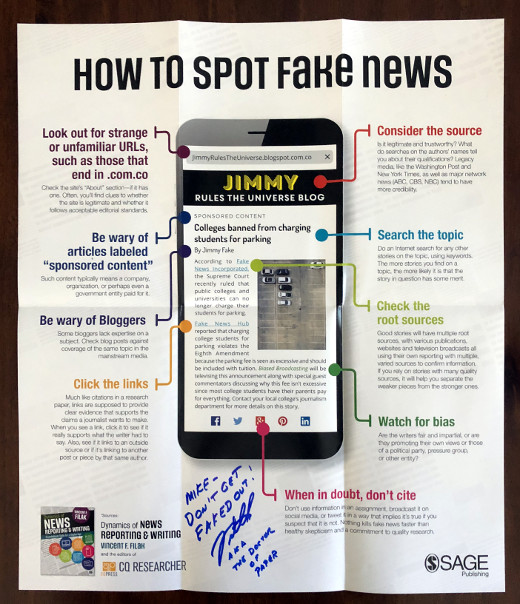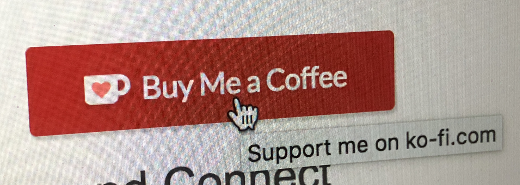My Guest Lecture at University of Wisconsin – Oshkosh on Consulting
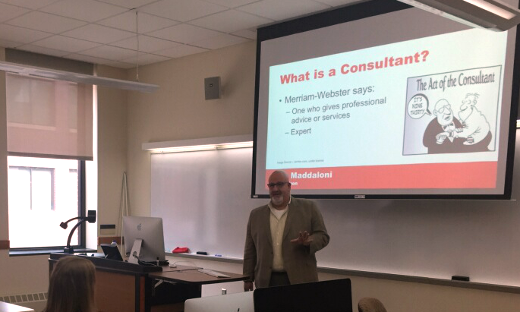
Great interactive classroom instruction coupled with real-world work opportunities provide the best educational experience for students. When you have the chance to help make that happen, it’s extremely rewarding. That happened for me recently as I was a guest lecturer at a university class.
I was honored to be asked once again by Dr. Sara Steffes Hansen, a professor at University of Wisconsin – Oshkosh and chair of the Journalism department. Her class, Application of New & Emerging Media, provides that educational experience working with entities in the community on their social media and beyond. As her students make on-site visits to their clients, I was asked to speak to the class on the topic of consulting.
Last year I spoke to students in the same class, but after their client visit, where this year it was ahead of it. As meeting face-to-face with clients involves many factors – factors many don’t execute on well – I incorporated a role play into the interactive lecture. With a “volunteer” student, I did an improvised sketch where the student was the client and I was the bumbling, unprepared consultant. This segued into my discussion on preparing for and executing on the on-site visit, as well as the follow-up and deliverables from the class assignment.
For me, this guest lecture served many purposes. As I have learned from others, both in the classroom and in the real world, I welcome the opportunity to share my experience and “war stories” with the students. As someone who still thinks and works like a consultant, poor consulting skills from others stick out like a sore thumb soaked in sriracha and lit on fire! If this lecture can help guide students down the path of honing their consulting skills, then the world will be that much better.
This class is part of the UW – Oshkosh’s Interactive Web Management major, which is a combination of curricula from Computer Science, Marketing, Journalism and Information Systems. It is a unique major, mashing up key aspects of each of these areas to offer a comprehensive educational background for how companies today are staffing roles in marketing and tech.
Where you needed to be enrolled in the class to get the full lecture, I am sharing my slides. You can link to the slides from my guest lecture here on SlideShare, or view them embedded below. I am planning on coming back to the class at the end of the semester to watch their client presentations. In the meantime I wish great success to the students of Journalism 61-440!
This is from The Hot Iron, a journal on business and technology by Mike Maddaloni.
Did you enjoy this? Subscribe to The Hot Iron by RSS/XML feed or Read by Email.
Announcements • Business • Strategize • Technology • Thrive • (0) Comments • Permalink
Talking About Fake News in 2004
It seems everywhere you look today you see something about fake news, from those calling something fake news to those who are defending themselves for not being fake news. However, the idea of fake news is nothing new, and as a matter of fact it was something that I was talking about publicly into 2004.
Yes, I said 2004, 14 years ago from now.
So why would I remember today what happened a decade and a half ago? Interestingly I was triggered to recalling it from a poster by a colleague of mine, Dr. Vincent Filak, professor of journalism at the University Wisconsin – Oshkosh. The poster is about how you can spot fake news and was created as a complement to his recently published collegiate textbook, Dynamics of News Reporting and Writing: Foundational Skills for a Digital Age.
Now let’s take a trip back along memory lane and talk about how even then I realized this was an issue that would be impacting not only news but the Internet and the Web as well.
Back in time
In the spring of 2004 I was asked to speak at the annual conference for winners from Massachusetts of the Hugh O’Brien Youth Leadership Award, best known as HOBY, that was taking place at (then) Babson College in Wellesley, Massachusetts. I had been a recipient of the award back in the 1980s when I was a high school sophomore and recently I had connected with the state HOBY organization in Massachusetts because of something I had written. Shortly after the death of retired New England Patriots player Ron Burton, who after leaving the football gridiron was a champion for charitable causes in the Boston area including the HOBY award, I had written about him on my former Web site GoPats.com – as I have retired that Web site, you can read the original article I wrote on Burton here thanks to the Internet Archives’ Wayback Machine.
After connecting with the HOBY organization about my article, they asked me to speak at their 2004 conference for 2 purposes, one as part of a remembrance of Burton and to participate in a panel about the media. The panel was would consist of Steve Burton, a Boston sportscaster for WBZ-TV and Ron’s son, sportswriter Dan Shaughnessy from the Boston Globe and myself, a technology strategist representing the Internet. I was honored to be asked to speak to the students, and I also realized the challenge of representing the Internet along with two well-known journalists, but I was up to the challenge.
As the conference began, following a video tribute of Ron Burton which included a video from Hugh O’Brian himself, I gave my tribute, talking about the 2 times I met him over the years. Next up was the panel on the media, with myself, Burton and Shaughnessy. Each of us had a few minutes for an introduction to talk about our expertise. Burton spoke first, then Shaughnessy and finally myself. As I listened to their opening statements I felt a little intimidated representing all of what the Internet was and is, but is someone who is been working with it professionally at that point for over a decade, I felt very comfortable and confident in sharing my knowledge to these young people who themselves never knew a time without the Internet.
Following this was a Q&A session where the students asked a lot of great questions. One in particular that I remember was on believing what you read online. First Burton spoke, and what I recall from his comments was him talking to journalistic integrity and how on television you had to make sure to get it right the first time, for even if you have the opportunity to retract it later, many people may not see that retraction as you would in a newspaper. When Shaughnessy spoke, he took more of a cavalier approach; I remember him started out by saying that you really can’t believe anything you read on the Internet. This was not surprising to me because this reflected his writing style, which I consider arrogant, and is why I only occasionally read his columns.
After his comment about not believing anything you read online, and while he was still talking, I reached into my blazer pocked and grabbed my PalmPilot handheld device (remember, this 2004 and PalmPilots were what we used back then!) and I opened up the Web clipping app for the Globe, Boston.com, and brought up an article was written by Shaughnessy about the Boston Red Sox that I had just read that morning. When it was my turn to respond I held it up my PalmPilot and, in a casual way, pointed out I had read Shaughnessy’s latest article online and questioned if I should believe it! He was a little taken aback by my opening line.
I continued my thoughts to the students by simply saying you should know your source. Whether you read it online or watch it on TV or read it in the newspaper, you should have an idea of where the information is coming from, and if the method you are reading it is a reputable one. I reinforced the point by saying if you are unsure, you should ask someone – a parent or teacher – and in any case they should take what they have consumed and form their own opinion. This approach is something I keep front of mind and share with others to this day.
And thus a modern journalism guide triggered me to remember that event from so long ago in context to today. To build on that, I not only try to understand the story but the headline as well – there are many Web sites and sources that deliver what ends up being misleading headlines in the hopes of you clicking on them, reading whatever the story is about, and in the process gaining ad impressions on their Web site. I have found these “fake headlines” linking to stories by legitimate journalists I am familiar with, only to read a story that doesn’t match the headline. Knowing your source is not only more involved but vital today.
Deconstructing Recognizing Fake News
Sadly I believe the idea of fake news has been around even longer than before I did my talk back in 2004. The concept of yellow journalism and opinions by early newspaper publishers have tried to influence readers for years. In a digital world where it takes much less resources to disseminate news – real or otherwise – being able to decipher the true from the fake has a greater importance. Where some look to the media companies and the government to solve this problem, the ultimate responsibility falls on ourselves. Buyer – or reader – beware!
This is from The Hot Iron, a journal on business and technology by Mike Maddaloni.
Did you enjoy this? Subscribe to The Hot Iron by RSS/XML feed or Read by Email.
Business • Strategize • (0) Comments • Permalink
Ciao ColdFusion

After recently re-reading my post about “retiring” my New England Patriots fan Web site GoPats.com, I realized that with its shutdown, I also took down the last remaining Web site I built using ColdFusion Web technology.
For those of you who are not technical – no fear, as this is not a technical post, rather one about a journey and choices made along the way – good and bad – and where I am today. So you don’t have to tune out just yet!
You Never Forget Your First Web Scripting Language
When I saw the very first graphical Web browser, NCSA Mosaic, shortly after it launched in 1993, I was hooked, and realized this is where I needed my career in technology to go – creating Web sites. Up to that point I was creating reports and screens on mainframe computers and there was nothing exciting about a black screen with white letters. So the playing and experimenting I did with Web sites – including GoPats.com – led to my first Web job a few years later.
For as much as I did to that point, when I started that job I quickly realized I still had a lot to learn. Another colleague at the small consulting firm I was at realized it too, and reminded me of it consistently! Eventually we would become friends and solid co-workers and even did a successful project that pissed off the president of said firm. And it was this colleague who one day early on in my time there asked me if I knew ColdFusion. I said no. He said that I could learn the basics of ColdFusion in an hour, creating a dynamic Web page that queried information from a database and displayed it in the browser. He also said that if I couldn’t do that in an hour that I was stupid! Needless to say I was able to do what he said and within 60 minutes. For me this was a big event, and got me started on more advanced Web site development.
Armed with this new skill, I wanted to use it, but my firm didn’t have any projects that required ColdFusion. So I sought out such projects elsewhere. As I had recently created a Web site for the Boston Jaycees, a non-profit organization I was involved with, I decided to apply ColdFusion code to it, giving the Board the ability to maintain the Web site with ease, and not requiring any HTML or any other coding knowledge. For 1997, this was rather unique. I then applied similar code to GoPats.com and some other personal Web projects, as well as some freelance Web projects I had taken on, work that would expand and eventually lead me to starting my own Web consulting business.
Becoming Web Multilingual
In 1996, as I started working for that small consulting firm, Microsoft didn’t have a Web strategy. By the following year it did, combining its Web browser and scripting language with some of its marketing genius. It was in 1997, when working on a project for a client using Microsoft’s client-server (e.g. PC-based) Visual Basic language, they asked me if I knew anything about the Web. I said yes, and they gave me a Microsoft Web server and its Web applications as part of my responsibility. Only one small thing, I didn’t know anything running a Web server or the language – Active Server Pages (ASP) – the applications were in. This has been a recurring theme throughout my career, but I digress. With the purchase of a few books and some guidance of a summer intern about 10 years my junior, I quickly got up to speed in developing Web pages and Web business applications for the client. Life was good.
All along, however, I was still working with ColdFusion – I had several sites using the technology, plus ColdFusion’s owner, Allaire, was in the Boston area and it had a good user group. There was, however, the beginnings of a change in the landscape. ColdFusion, for all of its ease of use and power, was a commercial product and to run it on one Web server cost somewhere over US$1,000. Microsoft’s Web server and ASP were free. There were other open-source (also free) Web scripting languages I was aware of, like Perl and PHP, though I was not using those at the time. Over time Allaire was acquired by Macromedia who was later acquired by Adobe. Though Web sites written in ColdFusion continued to work just fine even to this day, the Web language fell out of favor for many and they felt it was time to move onto other tools.
For myself, when I started my Web consulting business in 2004, I too was looking at other options, including other programming languages as well as packaged software instead of custom developed applications. This research was done along with the ColdFusion and ASP I was working with for my clients. All of my sites were powered by a content management system (CMS), going all the way back to my first Jaycees site. As time went on I continued to enhance and perfect my own CMS, but at the same time other CMS products came out that allowed me to do what I did best for clients, without the need for developing the CMS itself. Over time I migrated sites to these new platforms, but GoPats.com kept running just fine under ColdFusion.
All Good Things...
As I discussed back when I was doing some major digital spring cleaning and closed down some Web sites, GoPats.com was the last one to go. As updates to the site declined, the cost of Web hosting did not, and is was a cost savings as well. Where I had mixed emotions about this, simplifying the number of languages I was working with and needing to keep up on was also a time savings with all else I have going on in my life now.
So, “ciao, ColdFusion!” It was fun, and we had some great times. Where we may not see each other again anytime soon, we will always have the memories of the pioneering days of the World Wide Web.
Deconstructing Working With ColdFusion
As I said early on, this was not a technical discussion, rather one of choices. We make a lot of them through life and at the time, a good choice may not necessarily be the best one down the road. Though I didn’t choose ColdFusion initially, it worked well for me and I did make decisions about working with it or not over time, until I eventually decided it was not one to continue with. The technology continued to work right up until the end, and I know there is still ColdFusion code working very well today, and you can’t ask for more than that.
This is from The Hot Iron, a journal on business and technology by Mike Maddaloni.
Did you enjoy this? Subscribe to The Hot Iron by RSS/XML feed or Read by Email.
Build • Strategize • Technology • Web Development • (0) Comments • Permalink
Wisconsin Roundabouts To A Native Massachusetts Rotary Driver
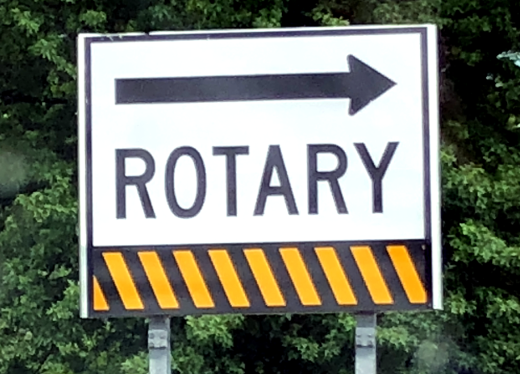
On a recent trip back to the Boston area I rented a car for the weekend, and as I slipped behind the wheel I also slipped back into Boston driving mode. Or at least as much as I could, as living in the Midwest for the last 15 years has dulled some of my Massachusetts driving edge. As I positioned my hands on the wheel, with my thumb on the horn, I hit the winding roads which were originally blazon by cattle, wagons and marching soldiers. And along the way, I went through a few rotaries.
Rotaries are what they (I?) call out East what I see as a growing occurrence locally here in Northeast Wisconsin, the roundabout. Where they are not anywhere a new invention, and certainly not one solely in the US, roundabouts are being put into place in the area that I now call home, and have been put into place, as the next coming of driving. And they are still going up on roads and intersections.
For someone who has been driving through this type of traffic pattern since I have been driving, I want to share my insights on them from Right to Mid Coast, and how I don’t see what the big deal is.
You Spin Me Right Round, Baby
My definition of a rotary – or roundabout – is a way for traffic to flow through an intersection of 2 or more streets without the need for a traffic light. Cars will approach the rotary, pause for incoming traffic, enter the rotary going around to the right of the center of the rotary, then exit it at the appropriate street. It of course requires everyone to obey these simple rules, and nobody or their cars gets hurt. Simple enough, right?
Growing up in Massachusetts, where most cities and towns predate most of the states in the US, these rotaries have always been there. Sure, some may have been added over time, but the convergence around a circle to get to the street you are heading was nothing new. Fast forward to the times I have been to Wisconsin prior to moving here last year, I have seen roundabouts being created in certainly the dozens over the years, and I hate to say it but to my amusement as well.
My Rotaries Are Not These Roundabouts
The above photo is from a rotary just north of Boston. It a more modern and much smaller sign, as traditional rotary signs were much wider – sometimes 2 or 3 times the width of this one – and much lower to the ground. In other words, when you approached a rotary, you wouldn’t be able to miss it. There also may be a Yield sign as you approach the rotary, but other than that you won’t see any other special road markings or signage that you were entering or going through a rotary in the Bay State. Why? I don’t recall the specific from the road test manual I studied in the early 1980’s.
Moving about 1,500 miles west, you find the rotaries in Wisconsin. Honestly, they are beautiful, and that goes beyond the landscaping. Overhead and side signage greet you as you approach the roundabout. The markings on the signs correspond to the markings on the road, as the road can flare into 2 or 3 lanes, depending on the intersection, on the options you have for going through the roundabout. These lanes continue through the roundabout until you exit it.
As you exit a roundabout, don’t be surprised if there is another one right next to it. Seriously. A whole, completely new roundabout, covering another set of streets including the one you just came in from the last roundabout. Though I don’t have insight into what the roads looked like previously, likely there was another traffic light, and if you are replacing one, then replace them all? Another scenario is you will have a roundabout at each side of a bridge by a highway exit. This “phenomenon” of adjacent roundabouts is something I still can’t get my head around fully, but of course manage to go through just fine.
Since I have moved here I have observed first hand and thru the media as new roundabouts open. One in particular was added at an intersection of 2 streets that had a high accident volume, presuming the roundabout would lessen or eliminate these accidents. However after it opened accidents continued and I personally observed many close calls going through it. Some say it is due to people’s lack of experience with roundabouts and I would agree with that. Though with the signage and lane markings, what to do is almost spoon-fed to you as you enter.
These Roundabouts Are Not My Hometown Rotary
As you may have sensed from the beginning of this, I laugh a bit about the roundabouts here in Northeast Wisconsin. But I have good reason. Many of these roundabouts are at the intersection of 2 or maybe 3 roads. As you approach a roundabout, even with the well-groomed circular island in the middle, you have a clear view of most all of the traffic that is approaching or coming through the roundabout.
It just so happened I grew up in East Longmeadow, Massachusetts, a suburb of Springfield. Where Springfield is the home of the US’s first armory and basketball, East Longmeadow is home to the wicked fast XLERATOR hand dryer and a rotary that ties together 7 streets. Yes, seven. Maple, Shaker, Prospect, Somers, Pleasant, Elm and North Main. You can see it for yourself on Google Maps if you don’t believe me. Seven streets was enough to get it listed in Ripley’s Believe It or Not, and interestingly the submission was by the builder of most of the homes in the town.
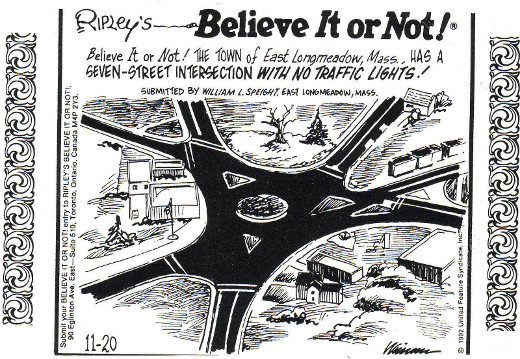
So when you see that car with the Patriots sticker on the back and Wisconsin license plates proceeding through the roundabout with confidence, it didn’t come overnight. When your first driving lesson started on Maple Street and you were headed into the East Longmeadow rotary, you best learn fast.
Deconstructing Roundabouts
The potential for less accidents, faster moving traffic and better fuel economy make roundabouts – and rotaries – a good choice for road improvements. In the short term as roundabout are built there will be both learning and cost curves – the more times you use a roundabout, the better experienced you are with them. But these come at a cost – I saw a new roundabout was well over US$1Million. Hopefully by the time people are used to driving through them the investments by communities in them will have at least broken even.
This is from The Hot Iron, a journal on business and technology by Mike Maddaloni.
Did you enjoy this? Subscribe to The Hot Iron by RSS/XML feed or Read by Email.
Strategize • Technology • (0) Comments • Permalink
Buy Me A Coffee With Ko-fi To Support The Hot Iron
Over the past decade plus that I have been writing here at The Hot Iron, I have mentioned this is a labor of love, writing and sharing my thoughts with you reading it. For most of that same time I have explored options to make a little money from my endeavor, and I present my latest one with Ko-fi.
Buy Me a Coffee, Please
I came across Ko-fi a couple of times in the same day, which prompted me to check into it. It is a free service which allows you to post a button to your Web site or share a link to your personal Ko-fi page, where someone can choose to buy you a coffee, which is in essence giving you money. You can choose to follow others on Ko-fi or have them follow you. You can try all of this yourself by clicking the "Buy Me a Coffee" button on the right column of my blog (or click the photo in this post), or follow this link to my Ko-fi page.
In order for me to receive the money (presumably earmarked for a hot caffeinated beverage) I tie my PayPal account to it, and funds are deposited there. As a result it is a straight cash transaction, and no actual coffee is exchanged in the process, unless I move the money from my PayPal account.
But wait, could there be more?
Where in some regard it is not much different than putting a PayPal donation button or link on my blog, Ko-fi is a unique approach as it is not an ask for cash rather an offer for someone to buy me a beverage. The community around the profile page shows the extent to how folks have supported by coffee consumption, which is usually not far from my keyboard or notebook when I am writing.
Of course when I see something like Ko-fi, the entrepreneurial part of my brain is triggered, and there is great potential for this service. The idea of micropayments are not new, but this is a new, unique way of asking for them. A coffee company - hello, Starbucks or Peet's - could be a sponsor or even an owner of it and tie their current gift cards and mobile apps to Ko-fi, thus making the coffee purchase that much easier to the recipient.
As I mentioned, Ko-fi is in a long line of methods for asking for contributions from my readers. I have had Google AdSense ads on my blog for years, which over time has contributed some but has waned as display ads become almost invisible and blocked by Web browser plug-ins. CentUp was a short-lived service which required you to create an account both to give and receive. Google Contributor offered the ability to block ads from being displayed if you contributed money to a site, but it has been all but eliminated by the search giant. Ko-fi is free, but asks me to buy it coffee, which I have done out of support for it, and to ensure its developers are well-caffeinated when doing their part.
Deconstructing Earning Revenue for Blogging
As the early days of the Web were driven by the free distribution of content, later attempts to earn revenue for content have had a mix of success. Large newspapers and magazines have struggled with earning digital subscribers as their print subscriptions plummet. Attempts at paywalls are met with people finding ways to avoid them and get the content for free. Smaller publishers have also had the same mixed results, most positives coming from extreme niche content. These gaps have driven services like Ko-fi to find a different way to help publishers earn money. Where others have failed, it remains to be seen if a unique payment service could gain traction. If anything, small publishers like myself are certainly cautiously optimistic.
This is from The Hot Iron, a journal on business and technology by Mike Maddaloni.
Did you enjoy this? Subscribe to The Hot Iron by RSS/XML feed or Read by Email.
Blogging • Business • Social Media • Strategize • (0) Comments • Permalink



